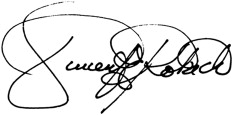I received the following e-mail from a general dentist who heard me lecture on interdisciplinary orthodontics.
Dear Dr Kokich: I am hoping that you might provide me with some insight about a case that I am struggling with. A patient was referred to me 4 years ago at 12 years of age. She is missing four maxillary permanent teeth and a mandibular incisor and will eventually need implants. I placed some temporary restorations on some of her narrow maxillary anterior teeth so the orthodontist could bracket these teeth and improve their position. He recently sent the patient back to me to approve the tooth position prior to bracket removal, stating that he thought she was ready for restorations. I met with him in my office to discuss her case. I told the orthodontist that I wished that he had left a space in the area of the missing mandibular incisor area to place an implant as well as more space in the other edentulous sites for easier restoration and a better occlusion. At that point, the orthodontist had a complete meltdown, telling me that I am never satisfied, and that I needed to just restore her teeth. This normally calm wonderful man came completely unglued and stormed out of my office. So, now I am stuck, and I really don’t know if this is the best orthodontic result possible or whether I should just restore the case. I need some advice. Thanks, The General Dentist
The general dentist included some photographs of the current dental casts mounted on an articulator, and it was obvious that more orthodontic treatment would be necessary. However, my goal was to help mend the rift between the orthodontist and the general dentist. So, I sent the following e-mail.
Dear General Dentist: I would like to help you and your orthodontic colleague work out this situation and come to a successful conclusion with your patient. In order to assist, it would be helpful if the orthodontist could send me the original diagnostic wax-up of the anticipated outcome of the orthodontic tooth movement prior to the proposed restorations. Once I see the wax-up, then I can offer some suggestions about the orthodontic possibilities. VGK
Later that same day, I received an e-mail from the general dentist, stating that he had contacted the orthodontist, and there was no original diagnostic wax-up of the expected prerestorative outcome of the orthodontic treatment. This patient was missing 4 maxillary teeth and a mandibular incisor. I cannot conceive how an orthodontist could complete satisfactory tooth positioning in a partially edentulous patient without first constructing a diagnostic wax-up to verify that the outcome would be acceptable to the dentist.
Suppose this same orthodontist was planning to have a new house built. Would he trust that the contractor could build this house without blueprints, drawings, and computer simulations of exactly where all doors, windows, and walls would be? A diagnostic wax-up is the key blueprint for success in interdisciplinary dentistry.
I construct a diagnostic wax-up for all patients who will require restorative intervention after orthodontic treatment. I initially meet with the restorative dentist to determine the necessary tooth positioning to adequately restore that patient. Then, armed with this information, I construct the diagnostic wax-up. I do not cut out the teeth from the dental casts; that task is performed by a laboratory technician. But I do give specific instructions about which teeth need to be sectioned. Then the laboratory gives me the sectioned casts, and I place the teeth in positions that realistically represent what is possible orthodontically.
An orthodontist must construct the wax-up because only the orthodontist knows what is possible during treatment. Once the wax-up is completed and approved by the restorative dentist, I make a copy for the restorative dentist, so that, before bracket removal, the dentist can accurately compare the wax-up with the results. The diagnostic wax-up prevents misunderstandings between orthodontist and dentist. It is our way to create the vision of what we expect to accomplish during prerestorative orthodontics.





